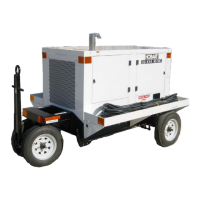OM-2098C / Operation and Maintenance Manual
60CU24 / Series 500060C / 400 Hz. Generator Set
April 01, 2005 Chapter 2-4
Page 11
Trouble, Symptom, Condition Probable Cause Test, Check, and/or Remedy
Engine Controls
a. Battery discharged, or loose
battery or ground connection.
Check voltage across batteries.
Voltage should be approximately
12.8 volts DC. Check all battery
terminals. Be sure 12.8 volts DC
is reaching solenoid input terminal.
b. Electrical defect in starter. Momentarily connect a large
capacity jumper cable (No. 1/0
minimum) between hot side of
starter solenoid and starter input
terminal. If starter does not crank
engine, proceed to step c. If
starter does crank engine, proceed
to step e.
c. Mechanical defect in starter. Remove starter motor from engine
and apply 12 VDC to test it. If it
doesn’t operate, it is defective.
Replace it. If starter motor does
operate, proceed to step d.
d. Internal seizure. If battery and starter are good and
starter is unable to crank the
engine, internal seizure is
indicated. Attempt to hand crank
engine with a ¾-inch square drive
on a long flex handle on
crankshaft pulley. If engine cannot
be turned one complete revolution,
internal seizure is indicated.
Remove engine and contact the
engine manufacturer and/or
nearest dealer.
e. Defective starter solenoid. Momentarily connect a large
capacity jumper cable (No. 1/0
minimum) between the auxiliary
solenoid terminals (one on each
side). If engine does not crank,
replace starter solenoid. If engine
cranks, proceed to step f below.
1. Engine will not start. Starter
will NOT crank engine.
f. Defective auxiliary starter
solenoid.
Momentarily connect a small lug
jumper on front of auxiliary
solenoid to the battery terminal of
the auxiliary starter If engine does
not crank, replace auxiliary starter
solenoid. If engine cranks,
proceed to step g below.

